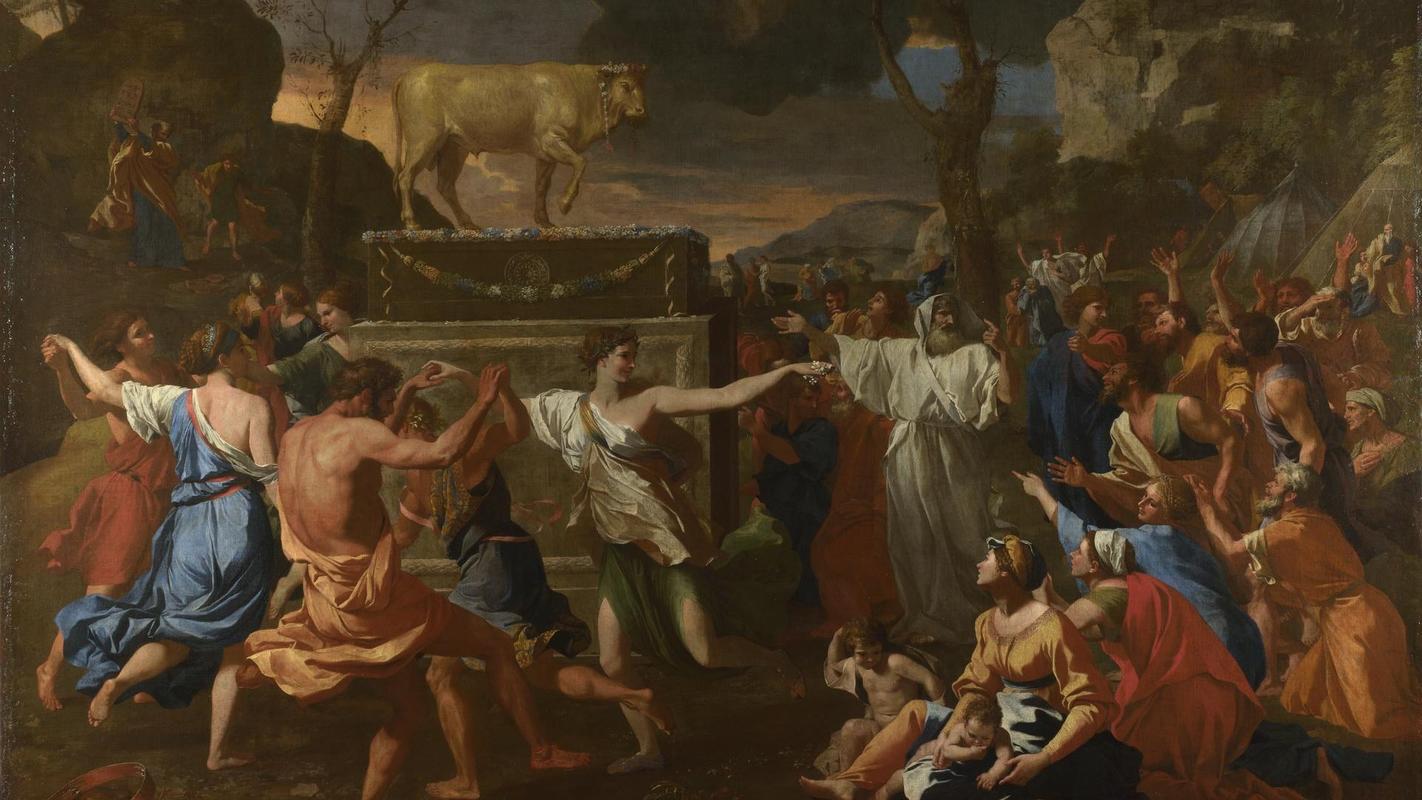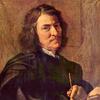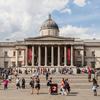More about The Adoration of the Golden Calf

Contributor
Nicolas Poussin’s The Adoration of the Golden Calf is one painting in a pair of Moses stories, along with The Crossing of the Red Sea.
Based on the book of Exodus, this painting shows the Israelites dancing wildly just after Moses leaves town, acting like kids left home alone with a cake in the fridge. Which is to say, things spiral quickly. Their de facto leader, Aaron, takes over and he’s the equivalent of a pothead babysitter who wants nothing more than to get paid to eat candy and watch television until the parents get home. But Aaron’s not just lazy, he’s somewhat smart, too. With Moses gone, he convinces everybody to fork over their golden earrings. He then proceeds to melt the earrings down and construct a giant, golden cow for the people to worship. Meanwhile, in the background of the painting, we see Moses returning in a state beyond anger. After his relaxing retreat to the mountains, during which he received the ten commandments directly from God, he comes back to find his people naked, dancing, and worshipping before a golden statue of a heifer. Moses has a cow (pun intended) and smashes the tablets on the ground.
While this painting is, in many ways, a classic Poussin religious painting, I think it’s time to get into the conspiracy theories. Due to a sloppy sign-off on this painting, a trivial argument broke out among historians. Was the piece painted in 1626 or 1629? While this face was never decided, it did spark another, far more interesting theory. Other art historians began to notice a few flaws. The painting looked sloppy, some even said, and uncharacteristic of Poussin's work. The date wasn’t the only slapdash thing on this painting, and this led art historians to believe that it wasn't done by Poussin at all. Some art historians even became so convinced that they exclude the painting entirely from his oeuvre.
And lastly, a bit of needless vandalism. In 2011, someone walked directly up to this painting and spray painted the entire bottom portion in red. Witnesses say that when he was done spraying, he stood there and admired his work until he was arrested.
Sources
- The Adoration of the Golden Calf by POUSSIN, Nicolas. Accessed October 30, 2019. https://www.wga.hu/html_m/p/poussin/2/17golden.html.
- Keazor, Henry. "Poussin, Titian and Mantegna: Some Observations on the 'Adoration of the Golden Calf' at San Francisco." The Burlington Magazine 137, no. 1102 (1995): 12-16. http://www.jstor.org.libproxy.newschool.edu/stable/886397.
- Jones, Jonathan. “Why Poussin's Golden Calf Was a Sitting Duck at the National Gallery.” The Guardian. Guardian News and Media, July 18, 2011. https://www.theguardian.com/artanddesign/jonathanjonesblog/2011/jul/18/…
Featured Content
Here is what Wikipedia says about The Adoration of the Golden Calf
The Adoration of the Golden Calf is a painting by Nicolas Poussin, produced between 1633 and 1634. It depicts the adoration of the golden calf by the Israelites, from chapter 32 of the Book of Exodus. It was made as part of a pair of paintings (the other being The Crossing of the Red Sea) commissioned by Amadeo dal Pozzo, Marchese di Voghera of Turin, a cousin to Cassiano dal Pozzo, Poussin's main sponsor in Rome. By 1685 the pair had passed to the Chevalier de Lorraine and in 1710 they were bought by Benigne de Ragois de Bretonvillers. In 1741 they were bought from Samuel by Sir Jacob Bouverie, whose son William became the first Earl of Radnor. The Earls of Radnor owned the pair from then until 1945, when it was split for the first time and The Adoration of the Golden Calf bought by the National Gallery in London for £10,000, half of which was contributed by the Art Fund. (The Crossing of the Red Sea was bought in the same 1945 sale by the National Gallery of Victoria.) It now hangs in Room 19 of the National Gallery, where it and Poussin's The Adoration of the Shepherds were vandalised with red spray paint on 17 July 2011. The French-speaking vandal covered up most of the nude figures.
Check out the full Wikipedia article about The Adoration of the Golden Calf













This image caught my attention because of the biblical story it is based on. The artist did a good job illustrating the foolishness of man apart from God. They dared to worship a statue instead of the God who just led them out of slavery.